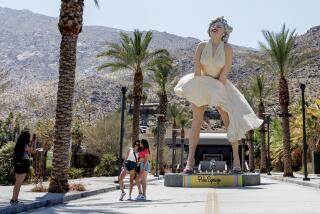They Are Now Trying to Duplicate F.D.R.’s Cover-up
- Share via
What would you expect from a sculptor who said he was inspired by the Hoover Dam when creating a statue of a nude woman? The sculpture, “Kneeling Lady,” so offended President Franklin D. Roosevelt, who had it commissioned in 1943, that he had hemlock bushes planted around it to hide it at his home in Hyde Park, N.Y. Recently, construction workers discovered the nude when they cut down the hemlocks to make way for a parking lot. Roosevelt had originally asked sculptor Robert Stackpole to duplicate a statue that the President greatly admired, calling it the ideal conception of feminine beauty. Stackpole wrote back that the statue had disappeared, but that he would create a new one. Later, he warned the President that he had changed the statue greatly. “The slender and graceful belong less to us now. I’ve tried to make heavy and strong forms. . . . Too, I thought of the great building in your Administration, especially the Hoover Dam,” Stackpole wrote. After its rediscovery, the statue, in keeping with Roosevelt’s wishes, was moved and once again encircled by hemlocks, said Frank Mares, supervisory ranger at the historic site.
--James Reston, the self-described do-or-die optimist who has held forth on the Op-Ed pages of the New York Times since 1953, will retire--sort of--to work on slowing his backswing and spending more time on Martha’s Vineyard “before they hang out the standing-room-only signs,” he wrote. Reston, 70, bade farewell to his reading public in Sunday’s editions of the New York Times in his regular “Washington” column. He will continue to write “occasionally” for the Op-Ed page and also for the newspaper’s magazine, Reston assistant Hilary Stout said. In his farewell, Reston said he remained an “up-to-date, stick-in-the-mud optimist.” “There are theaters of violence, rebellions and uprising of all sorts, mass hypocrisy, and false sincerity fueled by television, and a general decline in courtesy and a decay of decency, but I don’t despair,” he wrote.
--It’s becoming old hat to scale Japan’s towering Mt. Fuji. Just last month, 91-year-old Hulda Crooks of Loma Linda, Calif., conquered the peak to become the oldest woman to reach the top of Japan’s tallest mountain. Then on Sunday, 100-year-old Teiichi Igarashi became the first centenarian to scale the 12,385-foot summit. It was nothing new to Igarashi, who has climbed the mountain every year since he was 89.
More to Read
The biggest entertainment stories
Get our big stories about Hollywood, film, television, music, arts, culture and more right in your inbox as soon as they publish.
You may occasionally receive promotional content from the Los Angeles Times.










